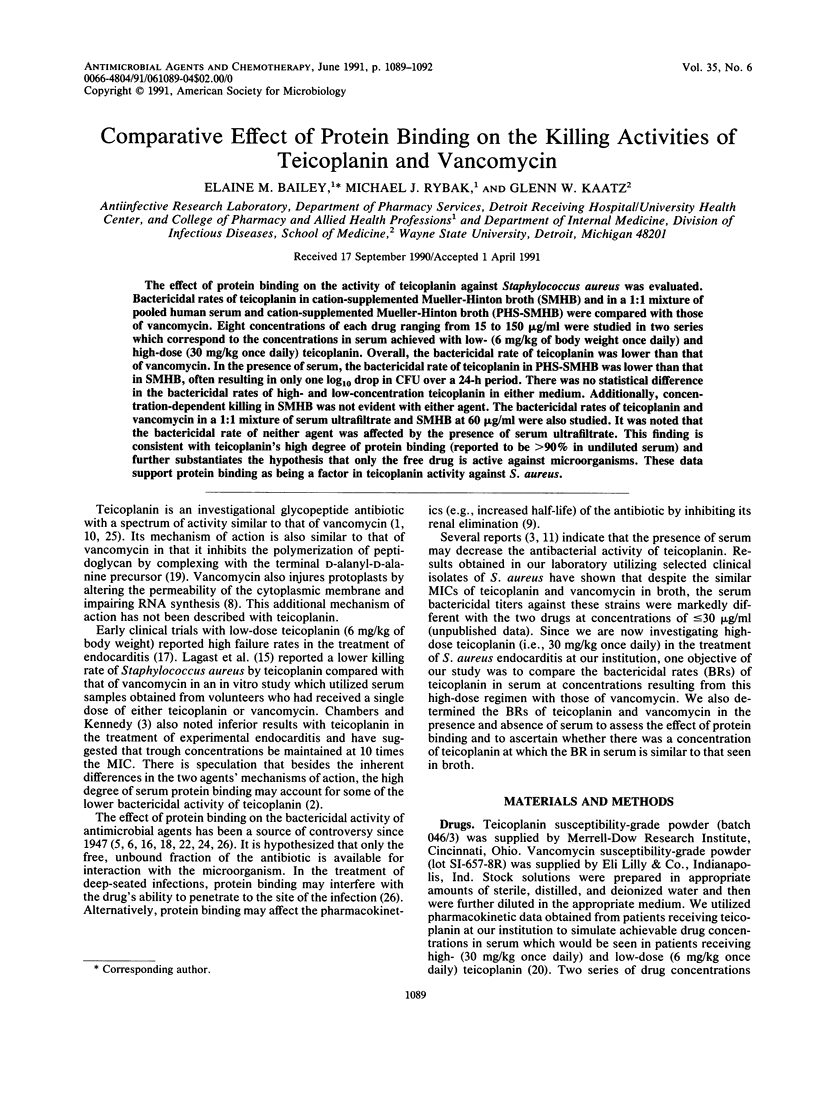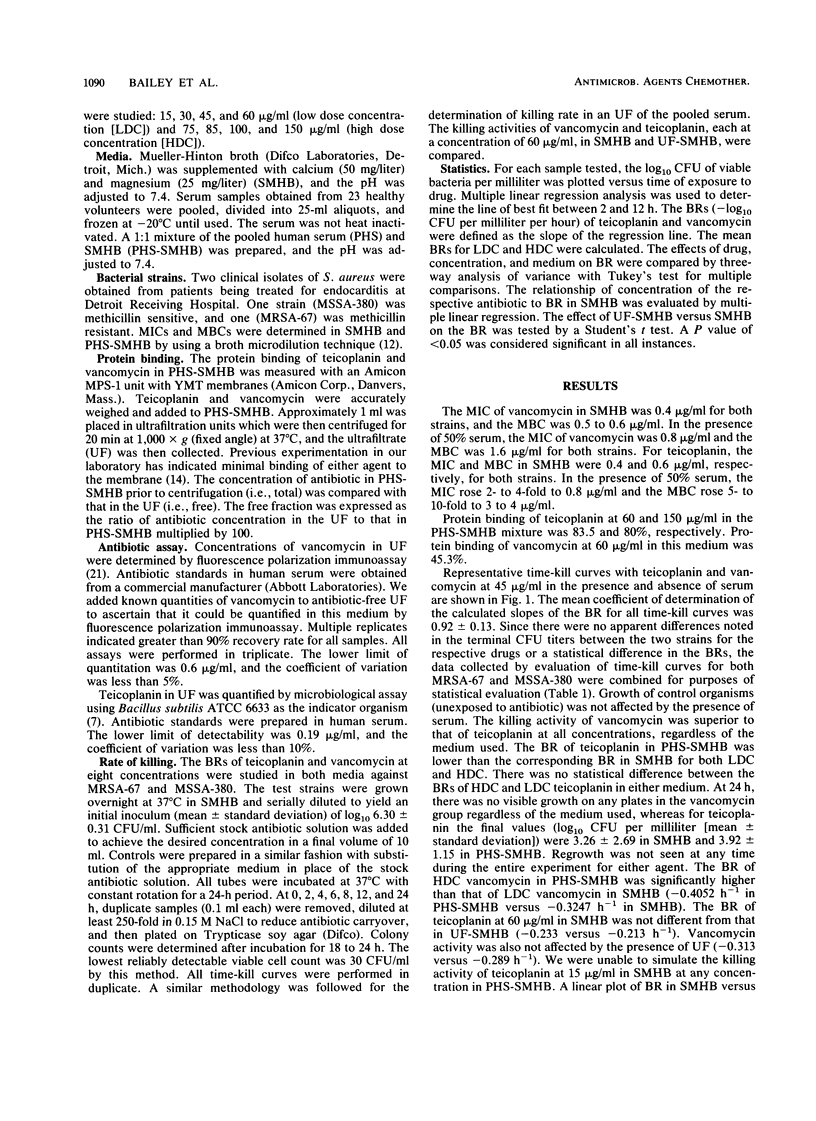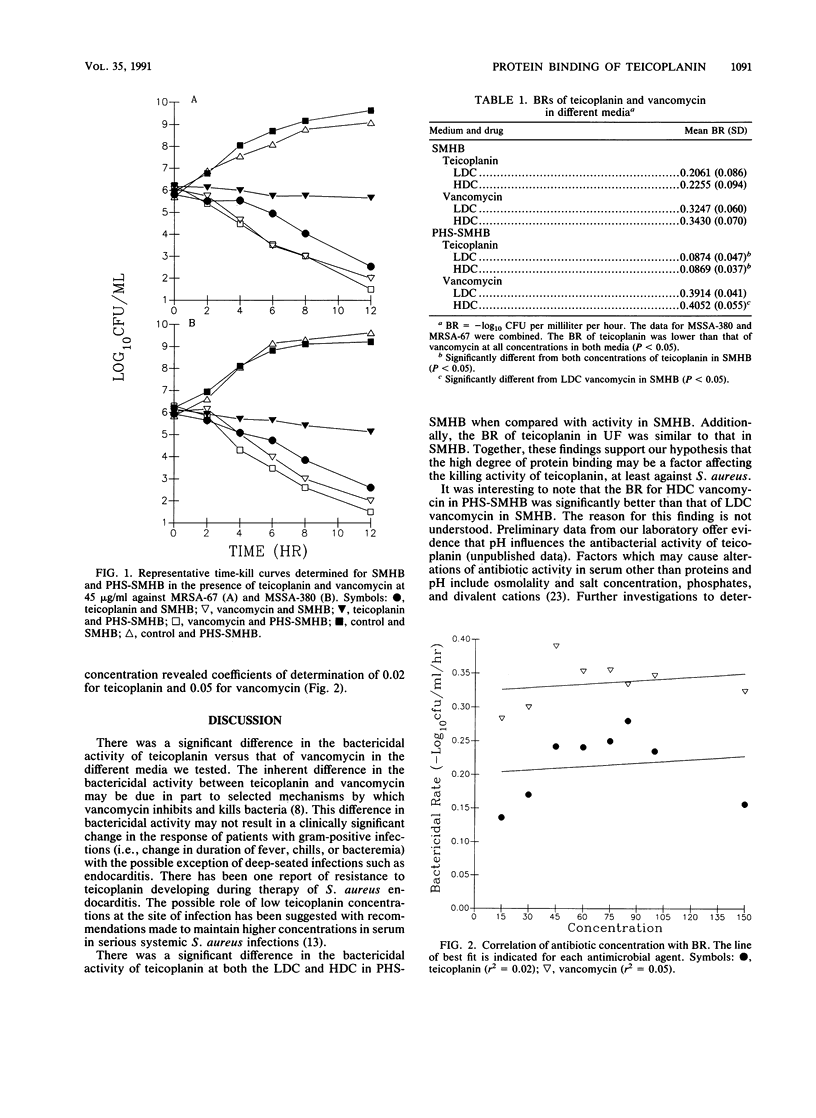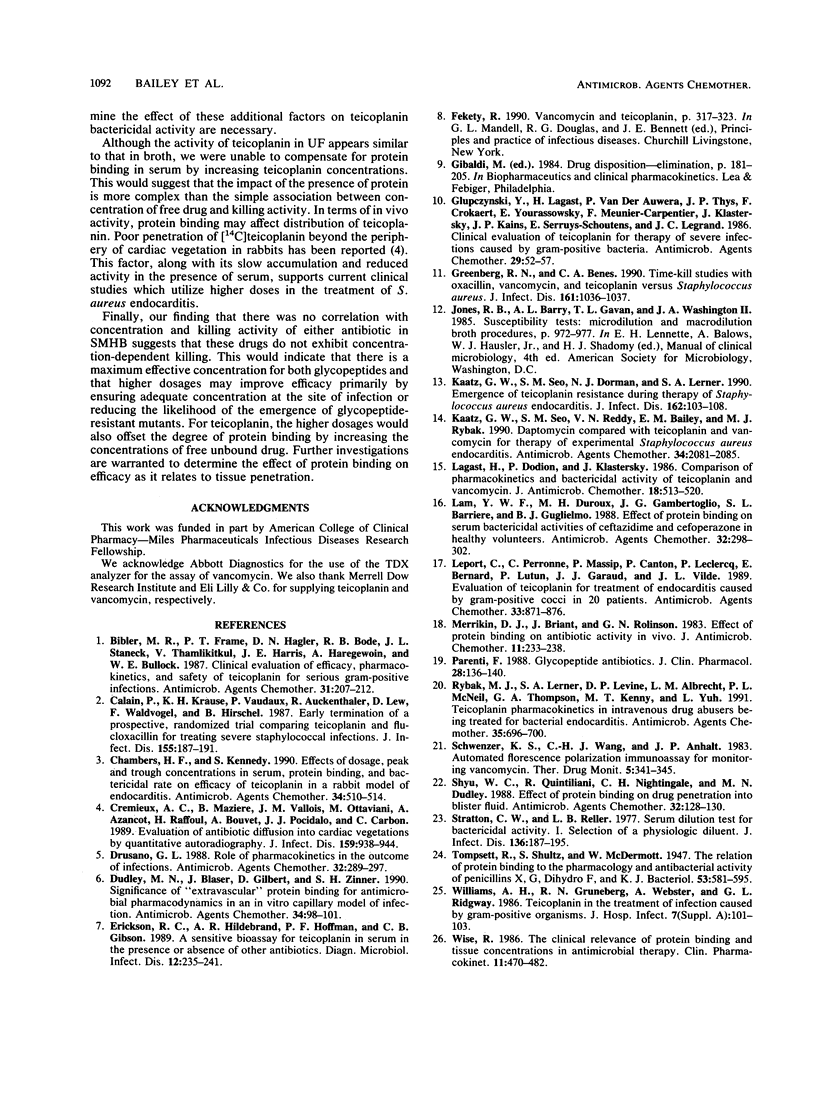Abstract
The effect of protein binding on the activity of teicoplanin against Staphylococcus aureus was evaluated. Bactericidal rates of teicoplanin in cation-supplemented Mueller-Hinton broth (SMHB) and in a 1:1 mixture of pooled human serum and cation-supplemented Mueller-Hinton broth (PHS-SMHB) were compared with those of vancomycin. Eight concentrations of each drug ranging from 15 to 150 micrograms/ml were studied in two series which correspond to the concentrations in serum achieved with low- (6 mg/kg of body weight once daily) and high-dose (30 mg/kg once daily) teicoplanin. Overall, the bactericidal rate of teicoplanin was lower than that of vancomycin. In the presence of serum, the bactericidal rate of teicoplanin in PHS-SMHB was lower than that in SMHB, often resulting in only one log10 drop in CFU over a 24-h period. There was no statistical difference in the bactericidal rates of high- and low-concentration teicoplanin in either medium. Additionally, concentration-dependent killing in SMHB was not evident with either agent. The bactericidal rates of teicoplanin and vancomycin in a 1:1 mixture of serum ultrafiltrate and SMHB at 60 micrograms/ml were also studied. It was noted that the bactericidal rate of neither agent was affected by the presence of serum ultrafiltrate. This finding is consistent with teicoplanin's high degree of protein binding (reported to be greater than 90% in undiluted serum) and further substantiates the hypothesis that only the free drug is active against microorganisms. These data support protein binding as being a factor in teicoplanin activity against S. aureus.
Full text
PDF



Selected References
These references are in PubMed. This may not be the complete list of references from this article.
- Bibler M. R., Frame P. T., Hagler D. N., Bode R. B., Staneck J. L., Thamlikitkul V., Harris J. E., Haregewoin A., Bullock W. E., Jr Clinical evaluation of efficacy, pharmacokinetics, and safety of teicoplanin for serious gram-positive infections. Antimicrob Agents Chemother. 1987 Feb;31(2):207–212. doi: 10.1128/aac.31.2.207. [DOI] [PMC free article] [PubMed] [Google Scholar]
- Calain P., Krause K. H., Vaudaux P., Auckenthaler R., Lew D., Waldvogel F., Hirschel B. Early termination of a prospective, randomized trial comparing teicoplanin and flucloxacillin for treating severe staphylococcal infections. J Infect Dis. 1987 Feb;155(2):187–191. doi: 10.1093/infdis/155.2.187. [DOI] [PubMed] [Google Scholar]
- Chambers H. F., Kennedy S. Effects of dosage, peak and trough concentrations in serum, protein binding, and bactericidal rate on efficacy of teicoplanin in a rabbit model of endocarditis. Antimicrob Agents Chemother. 1990 Apr;34(4):510–514. doi: 10.1128/aac.34.4.510. [DOI] [PMC free article] [PubMed] [Google Scholar]
- Cremieux A. C., Maziere B., Vallois J. M., Ottaviani M., Azancot A., Raffoul H., Bouvet A., Pocidalo J. J., Carbon C. Evaluation of antibiotic diffusion into cardiac vegetations by quantitative autoradiography. J Infect Dis. 1989 May;159(5):938–944. doi: 10.1093/infdis/159.5.938. [DOI] [PubMed] [Google Scholar]
- Drusano G. L. Role of pharmacokinetics in the outcome of infections. Antimicrob Agents Chemother. 1988 Mar;32(3):289–297. doi: 10.1128/aac.32.3.289. [DOI] [PMC free article] [PubMed] [Google Scholar]
- Dudley M. N., Blaser J., Gilbert D., Zinner S. H. Significance of "extravascular" protein binding for antimicrobial pharmacodynamics in an in vitro capillary model of infection. Antimicrob Agents Chemother. 1990 Jan;34(1):98–101. doi: 10.1128/aac.34.1.98. [DOI] [PMC free article] [PubMed] [Google Scholar]
- Erickson R. C., Hildebrand A. R., Hoffman P. F., Gibson C. B. A sensitive bioassay for teicoplanin in serum in the presence or absence of other antibiotics. Diagn Microbiol Infect Dis. 1989 May-Jun;12(3):235–241. doi: 10.1016/0732-8893(89)90020-5. [DOI] [PubMed] [Google Scholar]
- Glupczynski Y., Lagast H., Van der Auwera P., Thys J. P., Crokaert F., Yourassowsky E., Meunier-Carpentier F., Klastersky J., Kains J. P., Serruys-Schoutens E. Clinical evaluation of teicoplanin for therapy of severe infections caused by gram-positive bacteria. Antimicrob Agents Chemother. 1986 Jan;29(1):52–57. doi: 10.1128/aac.29.1.52. [DOI] [PMC free article] [PubMed] [Google Scholar]
- Greenberg R. N., Benes C. A. Time-kill studies with oxacillin, vancomycin, and teicoplanin versus Staphylococcus aureus. J Infect Dis. 1990 May;161(5):1036–1037. doi: 10.1093/infdis/161.5.1036. [DOI] [PubMed] [Google Scholar]
- Kaatz G. W., Seo S. M., Dorman N. J., Lerner S. A. Emergence of teicoplanin resistance during therapy of Staphylococcus aureus endocarditis. J Infect Dis. 1990 Jul;162(1):103–108. doi: 10.1093/infdis/162.1.103. [DOI] [PubMed] [Google Scholar]
- Kaatz G. W., Seo S. M., Reddy V. N., Bailey E. M., Rybak M. J. Daptomycin compared with teicoplanin and vancomycin for therapy of experimental Staphylococcus aureus endocarditis. Antimicrob Agents Chemother. 1990 Nov;34(11):2081–2085. doi: 10.1128/aac.34.11.2081. [DOI] [PMC free article] [PubMed] [Google Scholar]
- Lagast H., Dodion P., Klastersky J. Comparison of pharmacokinetics and bactericidal activity of teicoplanin and vancomycin. J Antimicrob Chemother. 1986 Oct;18(4):513–520. doi: 10.1093/jac/18.4.513. [DOI] [PubMed] [Google Scholar]
- Lam Y. W., Duroux M. H., Gambertoglio J. G., Barriere S. L., Guglielmo B. J. Effect of protein binding on serum bactericidal activities of ceftazidime and cefoperazone in healthy volunteers. Antimicrob Agents Chemother. 1988 Mar;32(3):298–302. doi: 10.1128/aac.32.3.298. [DOI] [PMC free article] [PubMed] [Google Scholar]
- Leport C., Perronne C., Massip P., Canton P., Leclercq P., Bernard E., Lutun P., Garaud J. J., Vilde J. L. Evaluation of teicoplanin for treatment of endocarditis caused by gram-positive cocci in 20 patients. Antimicrob Agents Chemother. 1989 Jun;33(6):871–876. doi: 10.1128/aac.33.6.871. [DOI] [PMC free article] [PubMed] [Google Scholar]
- Merrikin D. J., Briant J., Rolinson G. N. Effect of protein binding on antibiotic activity in vivo. J Antimicrob Chemother. 1983 Mar;11(3):233–238. doi: 10.1093/jac/11.3.233. [DOI] [PubMed] [Google Scholar]
- Parenti F. Glycopeptide antibiotics. J Clin Pharmacol. 1988 Feb;28(2):136–140. doi: 10.1002/j.1552-4604.1988.tb05737.x. [DOI] [PubMed] [Google Scholar]
- Rybak M. J., Lerner S. A., Levine D. P., Albrecht L. M., McNeil P. L., Thompson G. A., Kenny M. T., Yuh L. Teicoplanin pharmacokinetics in intravenous drug abusers being treated for bacterial endocarditis. Antimicrob Agents Chemother. 1991 Apr;35(4):696–700. doi: 10.1128/aac.35.4.696. [DOI] [PMC free article] [PubMed] [Google Scholar]
- Schwenzer K. S., Wang C. H., Anhalt J. P. Automated fluorescence polarization immunoassay for monitoring vancomycin. Ther Drug Monit. 1983;5(3):341–345. doi: 10.1097/00007691-198309000-00017. [DOI] [PubMed] [Google Scholar]
- Shyu W. C., Quintiliani R., Nightingale C. H., Dudley M. N. Effect of protein binding on drug penetration into blister fluid. Antimicrob Agents Chemother. 1988 Jan;32(1):128–130. doi: 10.1128/aac.32.1.128. [DOI] [PMC free article] [PubMed] [Google Scholar]
- Stratton C. W., Reller L. B. Serum dilution test for bactericidal activity. I. Selection of a physiologic diluent. J Infect Dis. 1977 Aug;136(2):187–195. doi: 10.1093/infdis/136.2.187. [DOI] [PubMed] [Google Scholar]
- Tompsett R., Shultz S., McDermott W. The Relation of Protein Binding to the Pharmacology and Antibacterial Activity of Penicillins X, G, Dihydro F, and K. J Bacteriol. 1947 May;53(5):581–595. doi: 10.1128/jb.53.5.581-595.1947. [DOI] [PMC free article] [PubMed] [Google Scholar]
- Williams A. H., Grüneberg R. N., Webster A., Ridgway G. L. Teicoplanin in the treatment of infection caused by gram-positive organisms. J Hosp Infect. 1986 Mar;7 (Suppl A):101–103. doi: 10.1016/0195-6701(86)90014-9. [DOI] [PubMed] [Google Scholar]
- Wise R. The clinical relevance of protein binding and tissue concentrations in antimicrobial therapy. Clin Pharmacokinet. 1986 Nov-Dec;11(6):470–482. doi: 10.2165/00003088-198611060-00004. [DOI] [PubMed] [Google Scholar]


